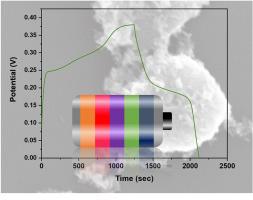Enhanced redox activity in microwave-synthesized Ce–Co LDH electrodes for solid state supercapacitor devices
IF 4.9
3区 材料科学
Q2 CHEMISTRY, MULTIDISCIPLINARY
引用次数: 0
Abstract
A novel layered double hydroxide (LDH) electrode material composed of cerium hydroxide (Ce(OH)3) and cobalt hydroxide (Co(OH)2) was developed to address the low energy density problem of conventional supercapacitor electrodes. The LDH was synthesized via a microwave-assisted co-precipitation technique, offering a rapid and eco-friendly route. Structural, morphological, and surface analyses confirmed the formation of well-defined nanosheet-like interconnected structures with favorable characteristics. Notably, the material exhibited a high specific surface area of 155.8 m2 g−1, conducive to enhanced electrochemical performance. X-ray photoelectron spectroscopy depicted the coexistence of Ce3+/Ce4+ and Co2+/Co3+ oxidation states, signifying a high density of electroactive sites. Electrochemical characterization in a three-electrode setup revealed a remarkable specific capacity of 688 C g−1 at 1 A g−1, compared to the pristine Ce(OH)3 (445 C g−1). A symmetric supercapacitor was assembled using the composite electrodes, delivering an energy density of 35 Wh kg−1 and a power density of 2250 W kg−1 along with excellent cyclic stability. The composite also demonstrated superior rate capability and long-term cycling stability, retaining 96 % of its capacitance after 10,000 charge–discharge cycles. The device maintained robust performance at elevated current densities and successfully powered a commercial LED for over 100 s, underscoring its practical applicability.

微波合成Ce-Co - LDH固体超级电容器电极的氧化还原活性增强
为解决传统超级电容器电极能量密度低的问题,研制了一种由氢氧化铈(Ce(OH)3)和氢氧化钴(Co(OH)2)组成的层状双氢氧化物(LDH)电极材料。采用微波辅助共沉淀法合成LDH,提供了一条快速、环保的途径。结构、形态和表面分析证实形成了定义良好的纳米片状互联结构,具有良好的特性。值得注意的是,该材料具有155.8 m2 g−1的高比表面积,有利于提高电化学性能。x射线光电子能谱显示Ce3+/Ce4+和Co2+/Co3+氧化态共存,表明电活性位点密度高。与原始Ce(OH)3 (445 C g−1)相比,在三电极设置下的电化学表征表明,在1 a g−1下,Ce(OH)3的比容量为688 C g−1。使用复合电极组装对称超级电容器,提供35 Wh kg - 1的能量密度和2250 W kg - 1的功率密度,并具有出色的循环稳定性。该复合材料还表现出优异的倍率性能和长期循环稳定性,在10,000次充放电循环后保持了96%的电容。该器件在高电流密度下保持了强大的性能,并成功地为商用LED供电超过100秒,强调了其实用性。
本文章由计算机程序翻译,如有差异,请以英文原文为准。
求助全文
约1分钟内获得全文
求助全文
来源期刊
CiteScore
7.80
自引率
2.50%
发文量
605
审稿时长
40 days
期刊介绍:
The Journal of Physics and Chemistry of Solids is a well-established international medium for publication of archival research in condensed matter and materials sciences. Areas of interest broadly include experimental and theoretical research on electronic, magnetic, spectroscopic and structural properties as well as the statistical mechanics and thermodynamics of materials. The focus is on gaining physical and chemical insight into the properties and potential applications of condensed matter systems.
Within the broad scope of the journal, beyond regular contributions, the editors have identified submissions in the following areas of physics and chemistry of solids to be of special current interest to the journal:
Low-dimensional systems
Exotic states of quantum electron matter including topological phases
Energy conversion and storage
Interfaces, nanoparticles and catalysts.

 求助内容:
求助内容: 应助结果提醒方式:
应助结果提醒方式:


